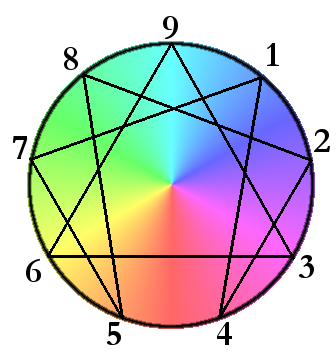 The enneagram is a personality assessment. The word ennea comes from the Greek word for “nine” and grammos which means “figure.” The literal translation is a “nine pointed figure.” The enneagram is a development of modern psychology which has roots in both philosophical and spiritual wisdom of ancient traditions. Some date it back to 2500 BCE. As a personality assessment, it is primarily concerned with self-knowledge.
The enneagram is a personality assessment. The word ennea comes from the Greek word for “nine” and grammos which means “figure.” The literal translation is a “nine pointed figure.” The enneagram is a development of modern psychology which has roots in both philosophical and spiritual wisdom of ancient traditions. Some date it back to 2500 BCE. As a personality assessment, it is primarily concerned with self-knowledge.
I prefer the enneagram to other personality assessments such as the Myers Briggs (or Keirsey Temperament sorter) because of its depth and possibilities. While the Myers-Briggs indicates individual preferences and talents, the enneagram identifies one’s underlying motivation – why people do what they do – which lends itself to an exploration of the healthy, average, and unhealthy behaviors extending from that motivation.
The practical applications – usefulness, if you will – of the enneagram include improved relationships with business colleagues, friends, and family, as well as personal and spiritual growth.
The best way to “type” yourself is to read the descriptions and decide which resonates best with you. There are a multitude of tests available – in paper and online. Some charge for the test, some are free. The one I tend to use when teaching is a free test available at Enneagram Central. Without a doubt, the most reliable test is the Enneagram Institute’s RHETI (Riso-Hudson Enneagram Type Indicator), which costs $10 and is available in paper and online. The Enneagram Institute offers a free (smaller) sampler version of the RHETI, but I don’t find it as reliable as the free test offered through Enneagram Central.
When I ask students to take the (free) online test, I always offer the following instructions:
- It would be best if you can answer each question without asking anyone what a given expression means. Why? Because you’re getting someone else’s interpretation bent by their personality. Try to answer the question with regards to your actual behavior (which is usually reflected in other people’s observations) unless the question is specifically asking for your feelings. Of course, feel free to ask those who know you to confirm whether or not you engage in certain behaviors; just try to avoid asking what questions or phrases mean.
- There are two (2) tests, each having a few sections. After taking them it will tell you your number (1-9). You should read the description and verify that it does reflect you (as the website itself indicates)
For a list of suggested resources, click here. I also recommend the Enneagram Institute for more information.
I am available to conduct trainings, workshops, and retreats. Please contact me through email for more information.

